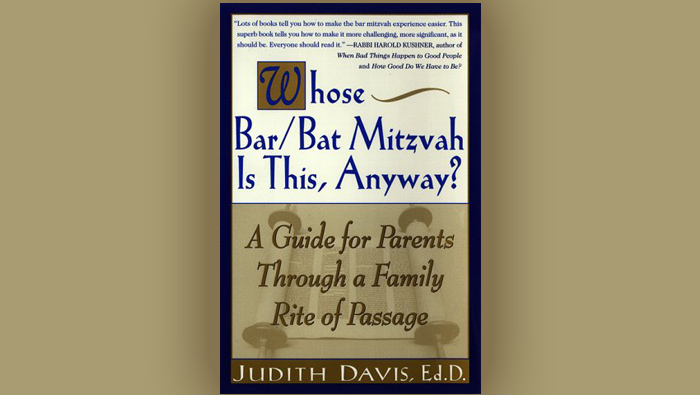Our child’s bar/bat mitzvah can work therapeutically in many different but complementary ways. Most basically, it works by providing us with a familiar format: a safe, protected structure for making and marking transitions. It makes our journeys public and positive.And it makes us cry. We cry with love and pride as our child soars, and we cry for all of the losses that come with that achievement. Our tears are as traditional as the Torah. And in that moment, surrounded by those who love us, our tears are healing. Whether an ailing grandparent is there in a wheelchair or there only in our words and in our prayers, our sorrow will be understood and shared by all. The people we have brought together for the bar/bat mitzvah ritual become our community, amplifying our happiness and cushioning our grief. This is what communities have done throughout the ages. This is what communities – and rituals – are for.
The bar/bat mitzvah ritual also has potential for healing in the way it works symbolically to mark boundaries and make connections. Yes, the bar/bat mitzvah is the child’s proclamation of growing maturity and eventual independence, but it is a proclamation being made in the embrace of the family and in the center of its tradition. It is a proclamation of increasing distance, yet paradoxically also one of connection and continuity. “Yes,” the child is saying, “I am growing up and away (and you can’t tell me what to do), but I will always be connected to my family, its culture and its tradition.” In this ceremonial performance, the ties between the generation that came before us and the one that follows us are strengthened.
Through the bar/bat mitzvah, the child enters the pivotal teenage years not only with an act of accomplishment that enhances his or her sense of pride and self-confidence, but with an expression of both separation and connection that is developmentally perfect. It is perfect because it represents exactly the shifting boundaries between closeness and distance that emerging adolescents need to be working on as they evolve their self-stories, their ideas about themselves as young people “getting ready” to become adults. And given that their stories and their parents’ stories are so interwoven, the bar/bat mitzvah’s capacity to help with these shifting stories is developmentally perfect for us too. Just as the experience helps our children develop confidence in themselves, it helps us have confidence in them – and in our own ability to know how much to hold on and how much to let go – not only as parents, but as partners and as children ourselves.
In a highly charged and dramatic way, the bar/bat mitzvah is a kind of story – a story that the family enacts about the child’s growing up. It is in this enactment that the child – the central character – gets to portray his or her unique version of the evolution, and the parents and grandparents – the other members of the cast – get to enact their versions of support. The invited family and friends, who have gathered as audience, witness and celebrate the enacted changes.
The bar/bat mitzvah works to promote growth and healing in yet another way as well. This “work” is much more prosaic, almost accidental, and generally unnoticed. It happens during the planning period, the months before the event when we are immersed in the nitty-gritty decisions about whom to invite, where to house them, what to feed them, where to seat them, what kind of party to have, what kind of music to play, etc.
These pragmatic decisions are, of course, about managing the size, shape, and feel of the event, but they are also about much more than that. Whether we consciously notice their potential or not, these decisions and the manner in which we make them often turn out to be opportunities for evolving new ways of relating to each other – new ways that our new life stages demand.
For instance, how we negotiate whose names will be on the invitation when there has been a remarriage can help estranged parents reach a new level of compromise and understanding. Such a shift could begin changing old patterns that have kept our child painfully choosing between us for years.
Allowing the bat mitzvah girl to wear the party dress we’d thought too grown-up could be an important message acknowledging her increasing maturity and our acceptance of it. Our choice to house both sides of the family in the same hotel, despite the still painful misunderstanding at the last family gathering, becomes an opportunity for reconciliation that would have been impossible with continued distance. At the very least, it is a message about our expectations that such movement is possible.
Our decision to invite Aunt Rosie, who’s been cut off from the family since Uncle Ben died, could begin healing wounds throughout that generation, many of which we aren’t even aware of. Our decisions about everything, from prayers to parties, guest lists to thank-you notes, are really decisions about relationships. They are the therapeutic opportunities hidden in the ritual’s details, the “work” that occurs as we outgrow old roles and take on new ones.
The above article was excerpted from Whose Bar/Bat Mitzvah Is This, Anyway? A Guide for Parents Through A Family Rite of Passage, by Judith Davis, Ed.D. Dr. Davis is a licensed family therapist, retired from the University of Massachusetts, Amherst, MA, and currently teaching at Antioch University, Keene, NH. She has published widely on ritual and family life development, and enjoys traveling to give workshops and presentations on these topics. She has a private therapy practice in Amherst, MA, working with couples and families. She can be reached at [email protected].






